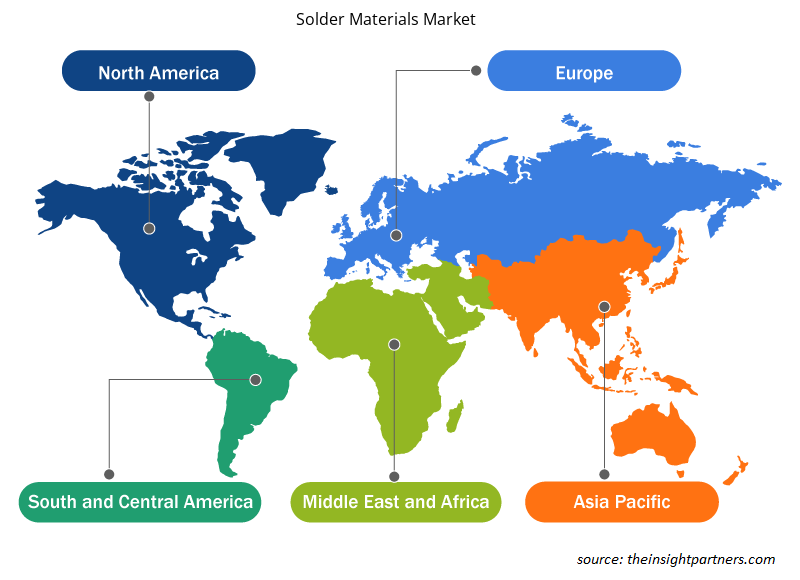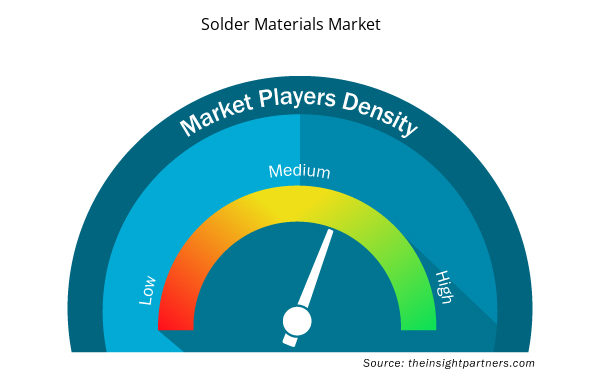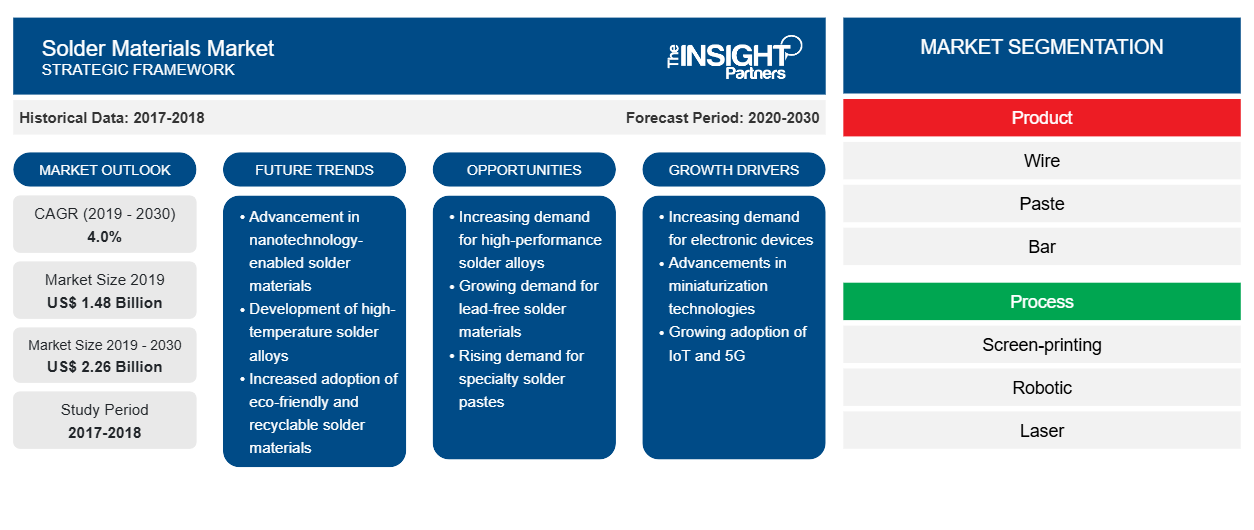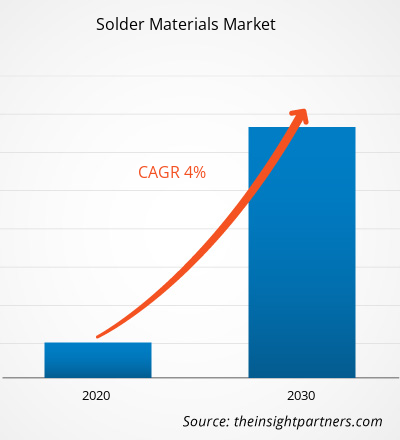Der Markt für Lötmaterialien hatte im Jahr 2019 einen Wert von 1.477,2 Millionen US-Dollar und soll von 2020 bis 2030 mit einer durchschnittlichen jährlichen Wachstumsrate von 4,0 % wachsen und bis 2030 2.255,3 Millionen US-Dollar erreichen.
Löten ist ein Verfahren, bei dem zwei oder mehr Metalle durch Schmelzen miteinander verbunden werden und anschließend ein Füllmetall, Lot genannt, in die Verbindung eingebracht wird. Das im Verfahren verwendete Füllmetall hat einen niedrigeren Schmelzpunkt als das angrenzende Metall. In den vergangenen Jahrzehnten enthielten fast alle Lote Blei; Umwelt- und Gesundheitsbedenken der Verbraucher haben jedoch zunehmend die Verwendung bleifreier Legierungen für Elektronik- und Sanitärzwecke vorgeschrieben. Lot wird in der Elektronik, im Sanitärbereich, im Bauwesen und in der Metallverarbeitung für die Versiegelung von Schmuck, Medizin und Musikinstrumenten verwendet. Lot sorgt hauptsächlich für einigermaßen dauerhafte, aber reversible Verbindungen zwischen Kupferrohren in Sanitärsystemen sowie für Verbindungen in Blechgegenständen wie Konservendosen, Regenrinnen, Dachversiegelungen und Autokühlern. Elektronisches Lot verbindet elektrische Leitungen mit Geräten und elektronische Komponenten mit Leiterplatten.
Der globale Markt für Lötmaterialien im asiatisch-pazifischen Raum wird voraussichtlich von 2020 bis 2030 mit einer durchschnittlichen jährlichen Wachstumsrate von 4,2 % wachsen. Die hohe Nachfrage nach Lötmaterialien und die Verlagerung der Verbraucher hin zu intelligenten elektronischen Produkten in dieser Region bilden eine starke Basis für den Markt für Lötmaterialien. Mit einem derart beträchtlichen Wachstum wird der asiatisch-pazifische Raum im Prognosezeitraum die attraktivste Region für den Markt für Lötmaterialien sein.
Der COVID-19-Ausbruch, der im Dezember 2019 in Wuhan (China) begann, hat sich rasant rund um den Globus ausgebreitet. Im Juni 2020 gehörten die USA, Russland, Indien, China, Italien, Spanien, Frankreich und Deutschland zu den am schlimmsten betroffenen Ländern im Hinblick auf die Zahl der bestätigten Fälle und der gemeldeten Todesfälle. Laut den im Juni 2020 aktualisierten Zahlen der WHO wurden weltweit etwa 7.482.952 bestätigte Fälle und 419.497 Todesfälle gemeldet. Der Ausbruch hat Volkswirtschaften und Industrien aufgrund von Ausgangssperren, Reiseverboten und Betriebsschließungen beeinträchtigt. Die Chemie- und Werkstoffindustrie ist eine der weltweit wichtigsten Industrien, die infolge dieser Pandemie unter schweren Störungen wie Lieferkettenunterbrechungen, Absagen von Technologieveranstaltungen und Büroschließungen leidet. China ist das globale Produktionszentrum und der größte Rohstofflieferant für verschiedene Industrien; es ist jedoch auch eines der am schlimmsten von der COVID-19-Pandemie betroffenen Länder. Die Schließung verschiedener Werke und Fabriken in China wirkt sich auf die globalen Lieferketten aus und hat negative Auswirkungen auf die Herstellung und den Verkauf verschiedener Chemikalien und Materialien. Der allgemeine Marktzusammenbruch aufgrund von COVID-19 wirkt sich auch auf das Wachstum des Lötmaterialmarktes aus, da Fabriken geschlossen werden, Hindernisse in der Lieferkette bestehen und die Weltwirtschaft abnimmt.
Passen Sie diesen Bericht Ihren Anforderungen an
Sie erhalten kostenlos individuelle Anpassungen an jedem Bericht, einschließlich Teilen dieses Berichts oder einer Analyse auf Länderebene, eines Excel-Datenpakets sowie tolle Angebote und Rabatte für Start-ups und Universitäten.
- Holen Sie sich die wichtigsten Markttrends aus diesem Bericht.Dieses KOSTENLOSE Beispiel umfasst eine Datenanalyse von Markttrends bis hin zu Schätzungen und Prognosen.
Markteinblicke
Steigende Nachfrage aus der Elektronikindustrie begünstigt weltweites Wachstum des Lötmaterialmarktes
Die steigende Nachfrage nach verschiedenen intelligenten elektronischen Geräten und die Einführung energieeffizienter Elektronik sind die Hauptfaktoren, die das Wachstum des Marktes für Lötmaterialien vorantreiben. Darüber hinaus wird erwartet, dass die steigende Produktion von elektronischen Geräten oder Gadgets in Entwicklungsländern in Verbindung mit der Präsenz einer bedeutenden Elektronik-Ersatzteilindustrie die Nachfrage nach Lötmaterialien ankurbeln wird. Herkömmliche Mikrometer-Lötmaterialien in der Paste weisen mehrere Mängel auf, wie z. B. hohe Schmelztemperaturen, die zu unerwünschten Spannungen während des Reflow-Prozesses, eingeschränkten Anwendungen und Defekten in der Verbindung führen können. Dies hat außerdem zur Einführung innovativer Lötmaterialien auf Submikrometer- und Nanopartikelbasis geführt. Daher werden diese Fortschritte im Bereich der elektronischen Aufarbeitung wahrscheinlich das Wachstum des globalen Marktes für Lötmaterialien vorantreiben. In der Elektronikindustrie werden verschiedene Arten von Lötmaterialien verwendet, wie z. B. bleifreies Lot, Lötdraht, Lötkugel und Lötstab. Bleifreie Lote werden aufgrund gesetzlicher Anforderungen sowie der gesundheitlichen und ökologischen Vorteile durch die Vermeidung bleihaltiger elektronischer Komponenten zunehmend in fast allen Anwendungen verwendet. Sie werden hauptsächlich in der Unterhaltungselektronik verwendet. Für Arbeiten im Elektro- und Elektronikbereich gibt es Lötdrähte in verschiedenen Stärken zum Handlöten und mit flussmittelhaltigen Kernen.
Produktinformationen
Basierend auf dem Produkt ist der Markt für Lötmaterialien in Drähte, Pasten, Stangen, Flussmittel und andere unterteilt. Das Drahtsegment hatte 2019 den größten Anteil am Weltmarkt, während der Markt für Pasten im Prognosezeitraum voraussichtlich die höchste durchschnittliche jährliche Wachstumsrate aufweisen wird. Lötdraht besteht aus verschiedenen Arten von Legierungen oder reinem Zinn. Da die Metallkombinationen, aus denen Lötdraht besteht, bei unterschiedlichen Temperaturen schmelzen, erfordert jedes Metall eine bestimmte Art von Lötdraht, um starke Bindungen zu bilden. Die am häufigsten in Lötdraht verwendeten Metalle sind Blei (Pb) und Zinn (Sn). Weichlot schmilzt grundsätzlich im Bereich von 190–900 °F. Bleifreie Lote werden zunehmend verwendet, um behördlichen Anforderungen gerecht zu werden, sowie um die gesundheitlichen und ökologischen Vorteile durch die Vermeidung bleihaltiger elektronischer Komponenten zu nutzen. Sie werden hauptsächlich in der Unterhaltungselektronik verwendet.
Prozesseinblicke
Basierend auf dem Verfahren ist der Markt für Lötmaterialien in Siebdruck, Roboter, Laser und Welle/Reflow unterteilt. Das Wellen-/Reflow-Segment hatte 2019 den größten Anteil am weltweiten Markt für Lötmaterialien, während das Robotersegment im Prognosezeitraum voraussichtlich die höchste durchschnittliche jährliche Wachstumsrate verzeichnen wird. Wellenlöten ist ein groß angelegter Lötprozess, bei dem elektronische Komponenten hauptsächlich auf eine Leiterplatte (PCB) gelötet werden, um eine elektronische Baugruppe zu bilden. Der Name leitet sich im Wesentlichen davon ab, dass Wellen aus geschmolzenem Lot verwendet werden, um Metallkomponenten an der Leiterplatte zu befestigen. Bei dem Verfahren wird ein Tank verwendet, der eine Menge geschmolzenes Lot enthält, und die Komponenten werden in die Leiterplatte eingesetzt, und dann wird die beladene Leiterplatte durch eine gepumpte Welle oder einen Wasserfall aus Lot geführt. Reflow-Löten ist eines der Verfahren, bei denen eine Lötpaste verwendet wird, um eine oder mehrere winzige elektrische Komponenten vorübergehend an ihren Kontaktflächen zu befestigen; später wird die gesamte Baugruppe kontrollierter Hitze ausgesetzt. Die Lötpaste fließt im geschmolzenen Zustand zurück und kann dauerhafte Lötverbindungen erzeugen. Bei diesem Verfahren wird die Erwärmung dadurch erreicht, dass die Baugruppe durch einen Reflow-Ofen oder eine Infrarotlampe geführt wird oder indem einzelne Verbindungen mit einem Heißluftkolben zum Entlöten gelötet werden.
Regionale Einblicke in den Markt für Lötmaterialien
Die regionalen Trends und Faktoren, die den Markt für Lötmaterialien im Prognosezeitraum beeinflussen, wurden von den Analysten von Insight Partners ausführlich erläutert. In diesem Abschnitt werden auch die Marktsegmente und die Geografie von Lötmaterialien in Nordamerika, Europa, im asiatisch-pazifischen Raum, im Nahen Osten und Afrika sowie in Süd- und Mittelamerika erörtert.

- Erhalten Sie regionale Daten zum Lötmaterialmarkt
Umfang des Marktberichts über Lötmaterialien
| Berichtsattribut | Details |
|---|---|
| Marktgröße im Jahr 2019 | 1,48 Milliarden US-Dollar |
| Marktgröße bis 2030 | 2,26 Milliarden US-Dollar |
| Globale CAGR (2019 - 2030) | 4,0 % |
| Historische Daten | 2017-2018 |
| Prognosezeitraum | 2020–2030 |
| Abgedeckte Segmente | Nach Produkt
|
| Abgedeckte Regionen und Länder | Nordamerika
|
| Marktführer und wichtige Unternehmensprofile |
|
Marktteilnehmerdichte: Der Einfluss auf die Geschäftsdynamik
Der Markt für Lötmaterialien wächst rasant, angetrieben durch die steigende Nachfrage der Endverbraucher aufgrund von Faktoren wie sich entwickelnden Verbraucherpräferenzen, technologischen Fortschritten und einem größeren Bewusstsein für die Vorteile des Produkts. Mit steigender Nachfrage erweitern Unternehmen ihr Angebot, entwickeln Innovationen, um die Bedürfnisse der Verbraucher zu erfüllen, und nutzen neue Trends, was das Marktwachstum weiter ankurbelt.
Die Marktteilnehmerdichte bezieht sich auf die Verteilung von Firmen oder Unternehmen, die in einem bestimmten Markt oder einer bestimmten Branche tätig sind. Sie gibt an, wie viele Wettbewerber (Marktteilnehmer) in einem bestimmten Marktraum im Verhältnis zu seiner Größe oder seinem gesamten Marktwert präsent sind.
Die wichtigsten auf dem Markt für Lötmaterialien tätigen Unternehmen sind:
- Fusion Incorporated
- Indium Corporation
- Kester
- KOKI Company Ltd
- Lucas-Milhaupt, Inc.
Haftungsausschluss : Die oben aufgeführten Unternehmen sind nicht in einer bestimmten Reihenfolge aufgeführt.

- Überblick über die wichtigsten Akteure auf dem Markt für Lötmaterialien
Bericht-Spotlights
- Fortschrittliche Branchentrends auf dem globalen Markt für Lötmaterialien, die den Akteuren bei der Entwicklung wirksamer langfristiger Strategien helfen
- In Industrie- und Entwicklungsländern angewandte Strategien für Unternehmenswachstum
- Quantitative Analyse des globalen Lötmaterialmarktes von 2017 bis 2030
- Schätzung des weltweiten Bedarfs an Lötmaterialien in verschiedenen Endverbrauchsbranchen
- PEST-Analyse zur Veranschaulichung der Wirksamkeit der in der Branche tätigen Käufer und Lieferanten bei der Vorhersage des Marktwachstums
- Aktuelle Entwicklungen zum Verständnis des Wettbewerbsmarktszenarios und der weltweiten Nachfrage nach Lötmaterialien
- Markttrends und -aussichten sowie Faktoren, die das Wachstum des globalen Marktes für Lötmaterialien vorantreiben und bremsen
- Verständnis der Strategien, die das kommerzielle Interesse im Hinblick auf das Wachstum des globalen Marktes für Lötmaterialien untermauern, was einen effektiven Entscheidungsprozess erleichtert
- Globale Lötmaterialien Marktgröße an verschiedenen Knotenpunkten des Marktes
- Detaillierte Übersicht und Segmentierung des globalen Marktes für Lötmaterialien sowie seiner Dynamik in der Branche
- Globale Marktgröße für Lötmaterialien in verschiedenen Regionen mit vielversprechenden Wachstumschancen in den jeweiligen Märkten
Lötmaterialienmarkt nach Produkt
- Draht
- Paste
- Bar
- Fluss
- Sonstiges
Markt für Lötmaterialien nach Verfahren
- Welle/Reflow
- Robotertechnik
- Siebdruck
- Laser
Firmenprofile
- Fusion Incorporated
- Indium Corporation
- Kester
- KOKI Company Ltd
- Lucas-Milhaupt, Inc.
- Qualitek International, Inc.
- Senju Metal Industry Co., Ltd.
- Stannol GmbH & Co. KG
- TAMURA Corporation
- Nihon Genma
- Historische Analyse (2 Jahre), Basisjahr, Prognose (7 Jahre) mit CAGR
- PEST- und SWOT-Analyse
- Marktgröße Wert/Volumen – Global, Regional, Land
- Branche und Wettbewerbsumfeld
- Excel-Datensatz


- Intradermal Injection Market
- Online Exam Proctoring Market
- Small Internal Combustion Engine Market
- Occupational Health Market
- Vessel Monitoring System Market
- Aircraft Wire and Cable Market
- Genetic Testing Services Market
- Resistance Bands Market
- Medical Collagen Market
- Grant Management Software Market

Report Coverage
Revenue forecast, Company Analysis, Industry landscape, Growth factors, and Trends

Segment Covered
This text is related
to segments covered.

Regional Scope
North America, Europe, Asia Pacific, Middle East & Africa, South & Central America

Country Scope
This text is related
to country scope.
Häufig gestellte Fragen
Major market share of wiresegment is primarily attributed to the fact that for electrical & electronics work, solder wire is available in the market with a range of thicknesses for hand-solder and with cores containing flux. It is further available as a room temperature paste. Jewelers often utilize solder in thin sheets, which they cut into snippets. A soldered joint is basically used to attach a wire to the pin of a component on the rear of a printed circuit board. Solder wire is comprised of different types of alloys, or of pure tin. Each metal requires a certain type of solder wire to create strong bonds, since the combinations of metals that comprise solder wire melt at different temperatures. Lead-free solders are increasing in use owing to regulatory requirements along with the health & environmental benefits towards avoiding lead-based electronic components. They are mostly used in consumer electronics. Steel wire, screwdrivers, nails, and Alan wrenches are all potential tools for emergency solder.
The major players operating in the globalsolder materialsmarketareFusion Incorporated, Indium Corporation, Kester, KOKI Company Ltd, Lucas-Milhaupt, Inc., Qualitek International, Inc., Senju Metal Industry Co., Ltd, Stannol GmbH & Co. KG, Tamura Corporation, and Nihon Genmaamong many others.
In 2019,the solder materialsmarket was predominantin Asia-Pacificat theglobal level.The APAC encompasses huge opportunities for the growth of soldermaterials. The region has surfaced as one of the prominent markets for the utilization of soldermaterials. Asia has ranked highest amongst electronics producing regions. Japan is dominating the regional market, followed by other countries such as China, India, Vietnam, Korea, Thailand, Malaysia, and Indonesia. These countries are witnessing growing demand from the electronic and automobiles industries. Apart from its applications in the electronic industry, the solder materials market has been propelling due to its applications in electronic vehicles. The price for petrol, diesel, and CNG, has increased subsequently that has created opportunities for the electric, coupled with a shift in consumer living standards. This shift has fueled the growth of the market in the region. Moreover, expanding disposable income and increasing purchasing capabilities are predicted to impact market growth positively.
Trends and growth analysis reports related to Chemicals and Materials : READ MORE..
The List of Companies - Global Solder Materials Market
- Fusion Incorporated
- Indium Corporation
- Kester
- KOKI Company Ltd
- Lucas-Milhaupt, Inc.
- Qualitek International, Inc.
- Senju Metal Industry Co., Ltd.
- Stannol GmbH & Co. KG
- TAMURA Corporation
- Nihon Genma
The Insight Partners performs research in 4 major stages: Data Collection & Secondary Research, Primary Research, Data Analysis and Data Triangulation & Final Review.
- Data Collection and Secondary Research:
As a market research and consulting firm operating from a decade, we have published and advised several client across the globe. First step for any study will start with an assessment of currently available data and insights from existing reports. Further, historical and current market information is collected from Investor Presentations, Annual Reports, SEC Filings, etc., and other information related to company’s performance and market positioning are gathered from Paid Databases (Factiva, Hoovers, and Reuters) and various other publications available in public domain.
Several associations trade associates, technical forums, institutes, societies and organization are accessed to gain technical as well as market related insights through their publications such as research papers, blogs and press releases related to the studies are referred to get cues about the market. Further, white papers, journals, magazines, and other news articles published in last 3 years are scrutinized and analyzed to understand the current market trends.
- Primary Research:
The primarily interview analysis comprise of data obtained from industry participants interview and answers to survey questions gathered by in-house primary team.
For primary research, interviews are conducted with industry experts/CEOs/Marketing Managers/VPs/Subject Matter Experts from both demand and supply side to get a 360-degree view of the market. The primary team conducts several interviews based on the complexity of the markets to understand the various market trends and dynamics which makes research more credible and precise.
A typical research interview fulfils the following functions:
- Provides first-hand information on the market size, market trends, growth trends, competitive landscape, and outlook
- Validates and strengthens in-house secondary research findings
- Develops the analysis team’s expertise and market understanding
Primary research involves email interactions and telephone interviews for each market, category, segment, and sub-segment across geographies. The participants who typically take part in such a process include, but are not limited to:
- Industry participants: VPs, business development managers, market intelligence managers and national sales managers
- Outside experts: Valuation experts, research analysts and key opinion leaders specializing in the electronics and semiconductor industry.
Below is the breakup of our primary respondents by company, designation, and region:

Once we receive the confirmation from primary research sources or primary respondents, we finalize the base year market estimation and forecast the data as per the macroeconomic and microeconomic factors assessed during data collection.
- Data Analysis:
Once data is validated through both secondary as well as primary respondents, we finalize the market estimations by hypothesis formulation and factor analysis at regional and country level.
- Macro-Economic Factor Analysis:
We analyse macroeconomic indicators such the gross domestic product (GDP), increase in the demand for goods and services across industries, technological advancement, regional economic growth, governmental policies, the influence of COVID-19, PEST analysis, and other aspects. This analysis aids in setting benchmarks for various nations/regions and approximating market splits. Additionally, the general trend of the aforementioned components aid in determining the market's development possibilities.
- Country Level Data:
Various factors that are especially aligned to the country are taken into account to determine the market size for a certain area and country, including the presence of vendors, such as headquarters and offices, the country's GDP, demand patterns, and industry growth. To comprehend the market dynamics for the nation, a number of growth variables, inhibitors, application areas, and current market trends are researched. The aforementioned elements aid in determining the country's overall market's growth potential.
- Company Profile:
The “Table of Contents” is formulated by listing and analyzing more than 25 - 30 companies operating in the market ecosystem across geographies. However, we profile only 10 companies as a standard practice in our syndicate reports. These 10 companies comprise leading, emerging, and regional players. Nonetheless, our analysis is not restricted to the 10 listed companies, we also analyze other companies present in the market to develop a holistic view and understand the prevailing trends. The “Company Profiles” section in the report covers key facts, business description, products & services, financial information, SWOT analysis, and key developments. The financial information presented is extracted from the annual reports and official documents of the publicly listed companies. Upon collecting the information for the sections of respective companies, we verify them via various primary sources and then compile the data in respective company profiles. The company level information helps us in deriving the base number as well as in forecasting the market size.
- Developing Base Number:
Aggregation of sales statistics (2020-2022) and macro-economic factor, and other secondary and primary research insights are utilized to arrive at base number and related market shares for 2022. The data gaps are identified in this step and relevant market data is analyzed, collected from paid primary interviews or databases. On finalizing the base year market size, forecasts are developed on the basis of macro-economic, industry and market growth factors and company level analysis.
- Data Triangulation and Final Review:
The market findings and base year market size calculations are validated from supply as well as demand side. Demand side validations are based on macro-economic factor analysis and benchmarks for respective regions and countries. In case of supply side validations, revenues of major companies are estimated (in case not available) based on industry benchmark, approximate number of employees, product portfolio, and primary interviews revenues are gathered. Further revenue from target product/service segment is assessed to avoid overshooting of market statistics. In case of heavy deviations between supply and demand side values, all thes steps are repeated to achieve synchronization.
We follow an iterative model, wherein we share our research findings with Subject Matter Experts (SME’s) and Key Opinion Leaders (KOLs) until consensus view of the market is not formulated – this model negates any drastic deviation in the opinions of experts. Only validated and universally acceptable research findings are quoted in our reports.
We have important check points that we use to validate our research findings – which we call – data triangulation, where we validate the information, we generate from secondary sources with primary interviews and then we re-validate with our internal data bases and Subject matter experts. This comprehensive model enables us to deliver high quality, reliable data in shortest possible time.


 Holen Sie sich ein kostenloses Muster für diesen Bericht
Holen Sie sich ein kostenloses Muster für diesen Bericht